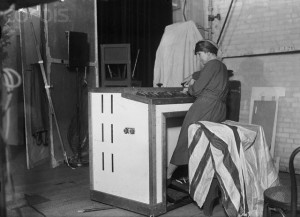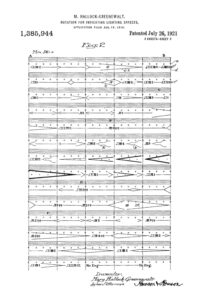
“Broadly, it is my desire to express emotions by means of timed variations of light and color in a manner analogous to that employed in the art of music. Such expression may either be for its own sake, or … as an accompaniment.”
In 1906, about 40 years after the invention of the commercial light bulb, Mary Hallock-Greenwalt (1871-1950) began work on her colour organ, the sarabet. She was an accomplished musician, but wanted to create an equivalent artform for colour which she called nourathar (derived from the Arabic for the essense/flavour/influence of light). Interestingly though, she came to the conclusion that colour wasn’t as important as brightness:
“In this art they, the darknesses and brightnesses, constitute the woof of the play. They carry a chief burden of the transmitted feeling. They also tend to make a oneness out of more than one colour, or colours, simultaneously produced.”
She was also quick to dismiss the idea of direct mappings between music and colour.
“… there is no octave to color. color has no harmonics. … Its pristine strength is such that no two colors can fit together as identical.”
While she composed nourathar pieces to accompany music, she was against cross-domain mappings in general.
“To seek to fasten the form of one art on the form of another art, is, on the face of it, a mistake, if not an impossibility. They are organically different things. They will speak in different ways.”
I’m not sure if I agree with this strong claim, the human senses are integrated after all. But I still think it insightful to reject the naive “colour scales” which others came up with — while synaesthetics can experience pitch as colour (or vice versa), I understand that no two synaesthetics experience the same scale.

All the quotes in this post came from Hallock-Greenewalt’s book “Nourathar: The Fine Art of Light-Color Playing”, which is a joy to read. She was not the first colour organist, but from what I’ve seen she was the most insightful and interesting of the bunch. Sadly however no video recordings can exist from back then, so we can only imagine what her performances could have been like, with only her notation to guide us.
I gave a quick dorkbot presentation about Mary Hallock-Greenewalt a couple of years ago, and one audience member jokingly accused me of inventing her to justify VJ culture with false history. Well her work is well documented in her writing and patent applications, but she should certainly be better known — I recently saw a talk about colour organists which didn’t mention her, despite her huge contribution to the field.
I’ll finish this post with one last quote from the woman herself.
“Is there no expressing of fervor in the deepening of a rose to red? Can quality of ardor not be suggested in the quickness or slowness with which this transition is done? Can zeal or eagerness not be expressed in the manner of change from blue to purple? Are colors not “warm” or “cold”? Is there not the fervid, the burning of intensity of feeling in the ray’s glowing into or embering back? So much there is to choose from.”
Posted on the occasion of Ada Lovelace day 2009.
Now that’s what I needed! A theme for my hour on local radio tonight. I’ll observe Ada-day even if the show is past midnight; it’ll still be the 24th in some countries. Female composers, feminist noise, here we go.
:¬)
Thanks, nice write up as well, I learned something new.
Kas.
Heh, have fun digging out your matriarchical techno records Kas.
This, on lights, and your other post about ?what? the taxonomy of taste …
… imagine pluging in the formula for a Julia set and getting music instead of graphics! heh sorta like synesthesia.
cheers
@bentrem
Great, Alex! I just found out about her the other day, while looking up early (female) visual music artists, saw her name in a list and followed the lead. Found her book and lots of other material! It looks really interesting. reat to see that you gave her some attention on your blog, even though it was almost 10 years ago. From my quick reads of some of the material I found, I totally agree that she deserves much more attention! Truly a pioneer.
Yes really great work! Glad you are getting into it, take care